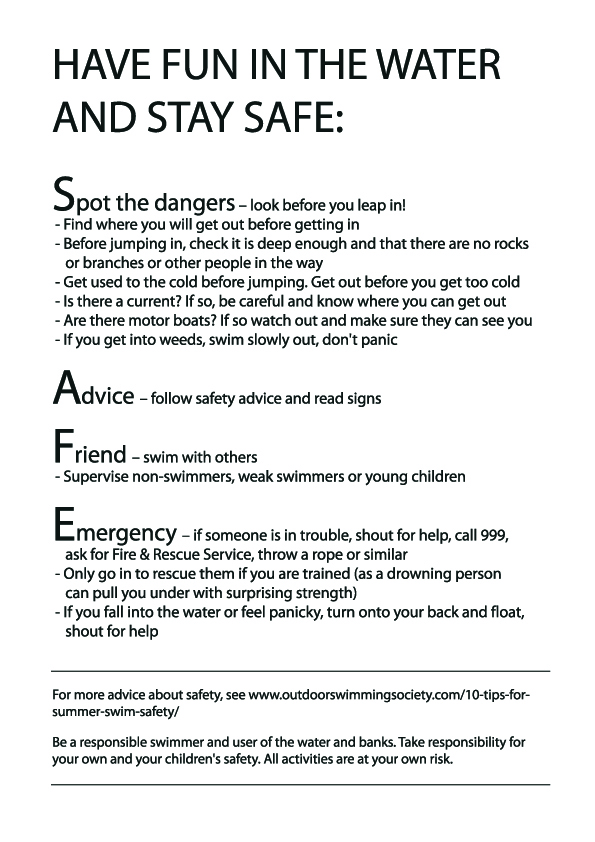See more up-to-date Page on Landowner liability and swimmers. This note, Updated 5 June, is my understanding of the responsibility of landowners now for people who choose to swim in waters on their land, generally (very briefly), and in the current situation with Covid 19. I’ve included some advice to swimmers that landowners might choose to give out. It applies in England only.
(Original note can also be downloaded (Word.doc 4 pages)
UPDATE 5 June: large numbers have gone out to be in or near rivers and lakes during the hot weather late May/early June, with some negative impacts. The swimming community is keen to be part of the solution to this, working with landowners where that is helpful: https://www.outdoorswimmingsociety.com/the-oss-and-lockdown-swimming/
More people start swimming in our rivers and waters, as the weather warms up and because it has now been specifically allowed by government guidance for England, as has driving further to exercise or enjoy the open air. People are still not all back at work or school, so will have more time for this.
Landowners and managers and local authorities might be worried about risks, liability, what is and isn’t allowed and what is or is not their responsibility. Many will already be very busy looking at government guidance and considering what they need to do, so are likely to be well aware of the guidance. But I thought it might be useful to outline this for those who haven’t, and also to do so from the swimmers point of view.
I hope this note might be helpful. I have drawn it up to the best of my understanding using publicly available and official resources, but landowners should seek advice themselves before relying on it.
More detail in this page on Landowner liability and swimmers
What are landowners responsible for?
(In general)
- If they know or suspect that people are swimming in waters in areas they manage, they need to warn about risks that are not obvious (so would need to assess the risks). For example deep water that someone might come across without seeing it, sluices or machinery they might not know were there. Note that this applies even if the landowner doesn’t allow swimming or even access to the area.
- It might be appropriate to warn that, for example, rivers could have been affected by floods over the winter and could contain unexpected obstructions.
(In relation to Covid 19)
- The government guidance on access to green spaces includes a section addressed to landowners – scroll down on this page https://www.gov.uk/government/news/coronavirus-guidance-on-access-to-green-spaces
- This points to their guidance for Safer Public Places during Coronavirus, though this is mainly designed for urban or very busy areas so different approaches might be appropriate when managing access to land in the countryside. It gives “… information and examples of interventions that may be undertaken by the owners and operators of public spaces to keep people safe …”. “[It]… does not impose any legal obligations”.
- They also link to their guidance for those managing outdoor work, including managing visitors or customers
What are landowners NOT responsible for?
- how far people drive, and whether they should or shouldn’t be doing so
- whether people are properly observing the physical distancing guidance and the legislation on who and how many are allowed to meet – EXCEPT as outlined in the government guidance linked to above (which focuses on urban/busy areas), where they are advised to provide information to the public on how to adhere to social distancing, and to make it easier for them to do so and to avoid the spread of the virus in other ways
- whether young people are out without parental supervision
- the decision to take risks made by informed adults
- warning people that the water is cold or of other obvious risks (though they might choose to warn about these and give advice – see below)
Some considerations
Some landowners in very popular beauty spots in the country have asked people not to come to those areas or to take extra risk, because they are concerned that distancing might be difficult, and that people might need to be rescued from mountains, for example.
Organisations with a safety role in relation to water, and organisations that influence swimmers, have advised swimmers to think very carefully before travelling to unfamiliar swim places, to make themselves familiar with risks and how to avoid them, and to avoid taking unnecessary or excessive risks. And a wide range of organisations have put out advice about keeping safe when swimming, including local swimming groups.
We might have views on whether people should be driving distances, swimming or doing other outdoor activities, but that’s not the purpose of this note. Some people believe that it is inappropriate for people to swim at the moment, but I believe that telling people that they shouldn’t swim because it is too dangerous isn’t based on an accurate assessment of the risks and that it is less constructive than giving them accurate and useful advice. And the government has recognised the importance of outdoor exercise for physical and mental health – a point that is encapsulated in the legislation, as well as guidance. (I have analysed the legislation and guidance on my website (and am trying to keep it up-to-date): https://www.imogensriverswims.co.uk/blog/can-i-swim-drive-with-whom/)
What are the risks for swimmers, and what advice could they be given?
The risks to people choosing to enter the water are the same as usual, except that there are likely to be more people who are unfamiliar with open water, who haven’t been in open water for a while and people who are not acclimatised to cold water by for example swimming over the colder months.
The risks can be mitigated by swimmers
- knowing their capabilities and staying well within them
- entering water gradually, initially staying in only for short periods, building up their acclimatisation to cool water over a period of time
- dressing quickly and warmly after the swim
- checking for obstructions and ensuring they are used to the cold before jumping into any water
- assessing for risks such as currents, and making sure they know where they can get out
- avoiding weeds and wildlife
- staying close to shore or bank
- being visible and avoiding boats, in navigable waters
- avoiding panicking – float on your back if you are feeling panicky or tired or cold and get out as soon as possible
Landowners do not have to warn about these risks or give advice, but they can if they wish. If they do so, they might also want to say something to indicate that they are not encouraging swimming, but that they are giving advice if people do choose to swim.
They can give advice in temporary notices, on their websites, circulars etc.
An example of a safety advice poster
In case it is helpful, this is the text of a poster I did for an organisation that was happy to encourage people to swim. The first line could change to
“WE ARE NOT RECOMMENDING THAT YOU SWIM, BUT IF YOU DO HERE’S HOW TO STAY SAFE”
“HAVE FUN IN THE WATER AND STAY SAFE:
Spot the dangers – look before you leap in! Find where you will get out before getting in.
Before jumping in, check it is deep enough and there are no rocks or branches or other people in the way, and get used to the water temperature first. Get out before you get too cold.
If you get into weeds, swim slowly out, don’t panic
Advice – follow safety advice and read signs
Friend – swim with others. Supervise non-swimmers, weak swimmers or young children
Emergency – call for help. Shout for help, call 999 and ask for Fire & Rescue service, throw a rope or similar, and only go in to rescue them if you are trained (as a drowning person can pull you under with surprising strength).
If you fall into the water or feel panicky, turn onto your back and float, shout for help.
For more advice about safety, see www.outdoorswimmingsociety.com/10-tips-for-summer-swim-safety/
Be a responsible swimmer and user of the water and banks. Take responsibility for your own and your children’s safety – all activities are at your own risk.”
Resources
Visitor Safety Group guidance, ‘Managing Visitor Safety in the Countryside: Principles and Practice’, new edition available for £20 from: https://www.ypdbooks.com/misc/2089-managing-visitor-safety-in-the-countryside-principles-and-practice-YPD02361.html
Chapter 2, ‘Guiding Principles’ explaining how to balance visitor access and safety (the earlier edition of this can be read on the VSG website, http://vscg.org/guiding-principles/). Find out about VSG and how to join https://vscg.org/.
RoSPA guidance, ‘Managing safety at inland waters guidance’ January 2019, has detailed information on the law and practical guidance for landowners using case studies. Sign up in box on their website (document link sent by email to download free PDF), https://www.rospa.com/leisure-safety/water/inland/
Note, Imogen Radford, project lead, Healing Waters, Download: Risks to health and safety of outdoor swimming, and how to mitigate them (Word.doc, 5 pages)
Outdoor Swimming Society guidance for landowners, ‘Inland Bathing Areas: a Guide to Setting up Inland Bathing Areas in the UK’, is explained and PDF is available for download, https://www.outdoorswimmingsociety.com/access-all-areas/
Disclaimer: I have drawn up this Note to the best of my understanding using publicly available and official resources, but landowners should seek advice themselves before relying on it.
Imogen Radford 150520. Healing Waters project lead volunteer, www.imogensriverswims.co.uk/blog/os-brecks-2/. The Healing Waters project is part of The Brecks Fen Edge & Rivers Landscape Partnership Scheme website (BFER), http://www.brecks.org/BFER/, supported by The National Lottery Heritage Fund, https://www.heritagefund.org.uk/


